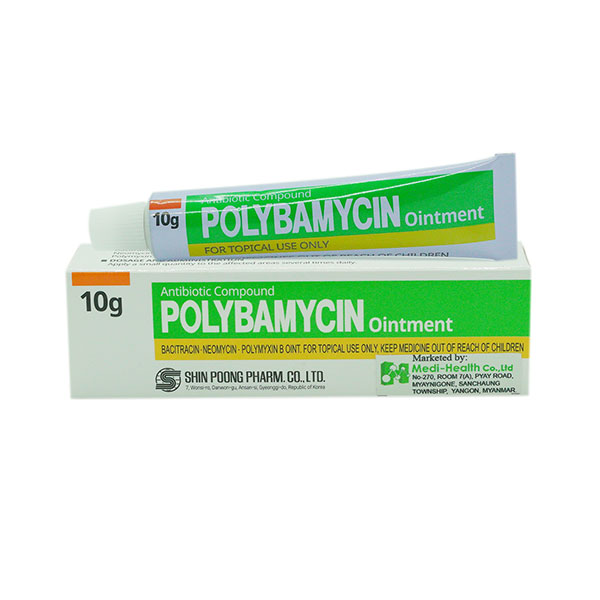POLYBAMYCIN
Bacitracin, Neomycin, Polymyxin B
Pharmacology and mechanism of action : Bacitracin is a polypeptide antibiotic created by Bacillus subtilis. Antibiotics consist of 3 separate substances: bacitracin A, B and C, of which bacitracin A is the main ingredient. Bacitracin has at least 40 active units of bacitracin activity in 1 mg. Previously bacitracin used for injection, but now the drug is only used locally limited because of high renal toxicity.Bacitracin can have a bactericidal or bacteriostatic effect, depending on the drug concentration achieved at the site of infection and on the susceptibility of pathogenic bacteria. Bacitracin inhibits the bacteria that synthesize the cell wall, due to the effect on the function of the lipid transporter molecule across the cell membrane, preventing the integration of amino acids and nucleotides into the cell wall. Bacitracin also damages bacterial cytoplasmic membranes and, unlike penicillin, acts against protozoa. Bacitracin works against many Gram-positive bacteria such as Staphylococcus (including some penicillin G-resistant strains), Streptococcus, anaerobic cocci, Corynebacterium and Clostridium. In vitro, concentrations of 0.05 to 0.5 micrograms / ml of bacitracin inhibit most susceptible strains of Staphylococcus aureus. It also works on Gonococcus, Meningococcus and Fusobacterium, but not on most other Gram-negative bacteria. Bacitracin also works with Actinomyces israelii, Treponema pallidum and T. vincenti. For susceptible bacteria, resistance is less likely to occur and, if present, appears slowly. Staphylococcus, including penicillin-resistant Staphylococcus G, is increasingly resistant to bacitracin. Bacitracin does not cause cross-resistance with other antibiotics.
Pharmacokinetics : Bacitracin is not absorbed from the gastrointestinal tract, pleural or synovial fluid. Bacitracin is rapidly and almost completely absorbed by intramuscular injection and is not significantly absorbed when taken outside.
Bacitracin widely distributed in all organs of the body, in ascites and pleural fluid after intramuscular injection. Bacitracin is low in protein.Bacitracin crosses the blood-brain barrier very little and only in trace form in the cerebrospinal fluid, unless the meninges are inflamed. Usually bacitracin used topically. Bacitracin injection is not safe due to high toxicity to the kidneys. There are now more effective and safer drugs, so bacitracin should not be used for injection. Bacitracin excreted in the stool if taken orally. After an intramuscular dose, 10-40% of the dose is slowly excreted by the glomeruli and appears in the urine within 24 hours. A large amount of bacitracin was not found and it is thought to be trapped or destroyed in the body.
Uses : - Bacitracin and bacitracin zinc are used externally, often in combination with other antibiotics, such as neomycin or polymyxin B, to treat skin diseases caused by susceptible bacteria.
- The drug is used to treat a number of eye diseases such as patchwork, acute and chronic conjunctivitis, corneal ulcer, keratitis and lacrimal inflammation.
Indication : - Infectious burns caused by susceptible bacteria.
- Primary pyoderma (impetigo, pustules, folliculitis, periitis)
- Secondary infectious dermatitis (eczema, shingles, seborrheic dermatitis, postoperative infections, grafting skin)
- Pus injuries, otitis.
DOSAGE - DOSAGE: Apply a small amount to the affected area 1-3 times / day.
UNWANTED EFFECTS
Because bacitracin is toxic to the kidneys, it should not be administered intravenously
and intramuscularly while many antibiotics are more effective and safer.
Common, ADR> 1/100:
Skin: Rash.
Uncommon, 1/1000 <ADR <1/100:
Hypersensitivity reactions including rash and anaphylaxis.
HOW TO HANDLING ADVERSE EFFECTS
Discontinue treatment if hypersensitivity reaction.
CAREFUL: Bacitracin for topical application. The drug may cause a delayed allergic reaction. It is also possible to cause shock-like states after topical application in hypersensitivity patients. Care should be taken when rubbing on an open wound. Bacitracin absorbed through wounds, bladder, abdominal fluid, can cause side effects, although this toxicity is usually caused by neomycin. Bacitracin is often used in combination with neomycin and polymyxin B sulfate. Should not be treated with this preparation for more than 7 days.
Pregnancy: There have been no announcements about the use of bacitracin teratogenic. However, do not use bacitracin during pregnancy.
Lactation period: There are no documents mentioned.
CONTRAINDICATIONS : History of hypersensitivity to the drug.
PACKING: Box of 1 tube 10g
PRESERVATION : Bacitracin zinc is more stable than bacitracin and can be stored for 18 months at temperatures up to 40 ° C without losing significant effect.
PRODUCER: ShinPoong Daewoo Pharmaceutical Co., Ltd.


